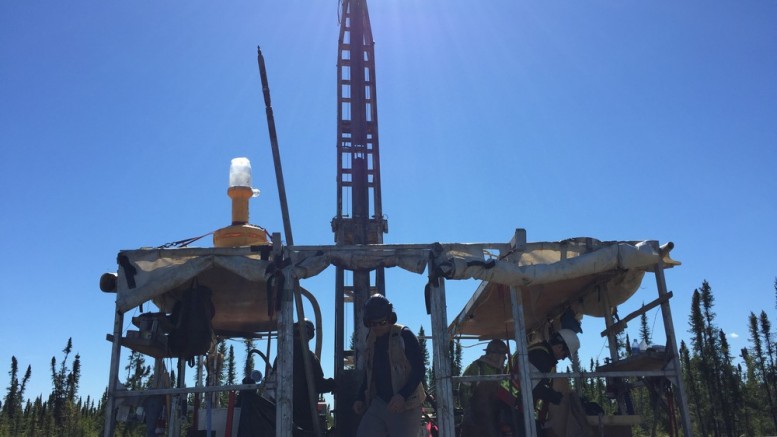VANCOUVER — NexGen Energy (TSX: NXE; US-OTC: NXGEF) just can’t stop making discoveries at its Rook I uranium property in Saskatchewan’s Athabasca basin. The company made headlines earlier this year with an impressive maiden resource at its Arrow deposit, and now summer drilling along the regional Patterson Lake corridor appears to have once again hit pay dirt.
The new Harpoon zone lies 4.7 km northeast of the core Arrow deposit, which hosts 3.5 million inferred tonnes grading 2.6% uranium oxide for a contained 202 million lb. uranium. Discovery hole 16-8 intersected 17 metres of continuous mineralization from 220 metres down hole, including 4.5 metres of off-scale radioactivity.

The camp at NexGen Energy’s uranium property in northern Saskatchewan. Credit: NexGen Energy.
Harpoon is on land and starts at 210 metres deep. The discovery was made after drills collared 250 metres northeast along trend from hole 16-6, which cut 1.5 metres of continuous mineralization from 303 metres deep. Uranium occurrences between Arrow and along trend to Harpoon have been traced over a 5.6 km mineralized strike length.
“The Harpoon discovery is defined by strong, visible uranium mineralization that includes dense accumulation of massive to semi-massive pitchblendes. The intensity of the mineralization is consistent with that found in the high-grade A2 domain at Arrow,” CEO Leigh Curyer said during a conference call.

Project map across the western Athabasca Basin, including the Patterson Lake corridor. Credit: NexGen Energy.
“What we’ve learned at Arrow and Harpoon has severely elevated the prospectivity of our regional targets. It’s exciting because Rook I is in its relative infancy, considering the limited drilling along the Patterson Lake corridor to date, and it’s clear our exploration team has proven their understanding of the technical features across the property,” he added.
The Arrow discovery has royalty and ownership specifics. Harpoon sits on a part of Rook I that is subject to a 2% net smelter return royalty, though NexGen can repurchase 1% for $1 million.
In addition, Rio Tinto (NYSE: RIO) is entitled to 10% of future production at Harpoon if it pays a 10% pro-rata part of the collective expenses from June 20, 2005. Curyer estimated that NexGen has invested $3.5 million on the Harpoon area to date.

Flying into the Rook I exploration camp in Saskatchewan. Credit: NexGen Energy.
NexGen is in the midst of its busiest exploration season so far at Rook I, with seven rigs set to drill 43,000 metres in the mid-year campaign. The company is working to increase its confidence in the core Arrow mineralization, while focusing on its recently discovered 180 zone, which sits 180 metres southwest of the main resource. Two rigs are also dedicated to regional exploration along the Patterson Lake corridor.
“We’re on track to complete our summer program, and our team will assess whether to mobilize additional rigs. A rig will be staying at Harpoon, and another one may join it in the near future,” Curyer said.

Seven drill rigs are mobilized across Rook I for NexGen’s 43,000-metre summer program. Credit: NexGen Energy.
“We’ve always maintained a degree of focus on regional targets because our mandate is to understand what we have globally. We remain focused on the Patterson Lake corridor, which is still relatively under-drilled. We have a number of other prospective corridors at Rook I, and multiple geophysical targets that look identical to what we’re seeing at Arrow. I’m not aware of a property on the planet that’s comparable,” he said.
The discovery success will likely delay a resource update NexGen had scheduled for later this year. Curyer speculated that the 180 zone would be incorporated into the Arrow footprint, which would push the release date to the first quarter of 2017.

Stacks of core boxes at the Rook I camp. Credit: NexGen Energy.
Paradigm Capital senior analyst David Davidson noted that Harpoon “reinforced the view that [Rook I] truly is a world-class discovery, and Arrow is just one pearl on the string.” He said Arrow likely “already exceeds 300 million lb. [uranium oxide],” even before incorporating the 180 zone and new A5 shear zone. Paradigm has a “buy” rating on NexGen, along with a $3.50-per-share, 12-month price target.
NexGen has traded within a 52-week range of 56¢ to $2.86, and gained 5%, or 12¢, on the Harpoon news, en route to a $2.50-per-share close at press time. The company has 303 million shares outstanding for an $815-million market capitalization, and recently closed a US$60-million unsecured convertible debentures with Hong Kong billionaire Li Ka-shing’s CEF Holdings.


Be the first to comment on "NexGen unveils Harpoon discovery"